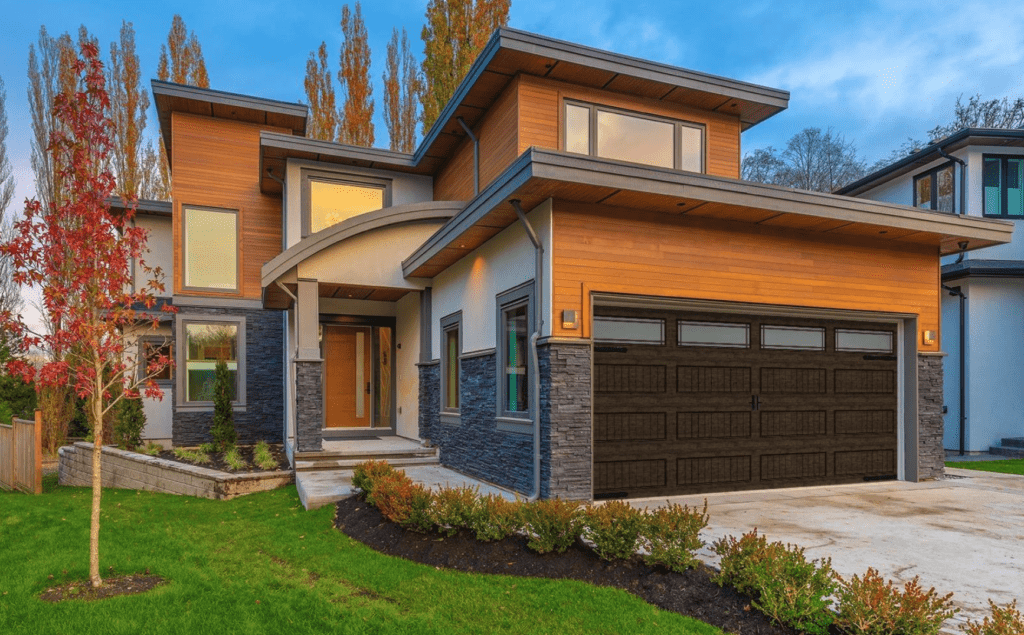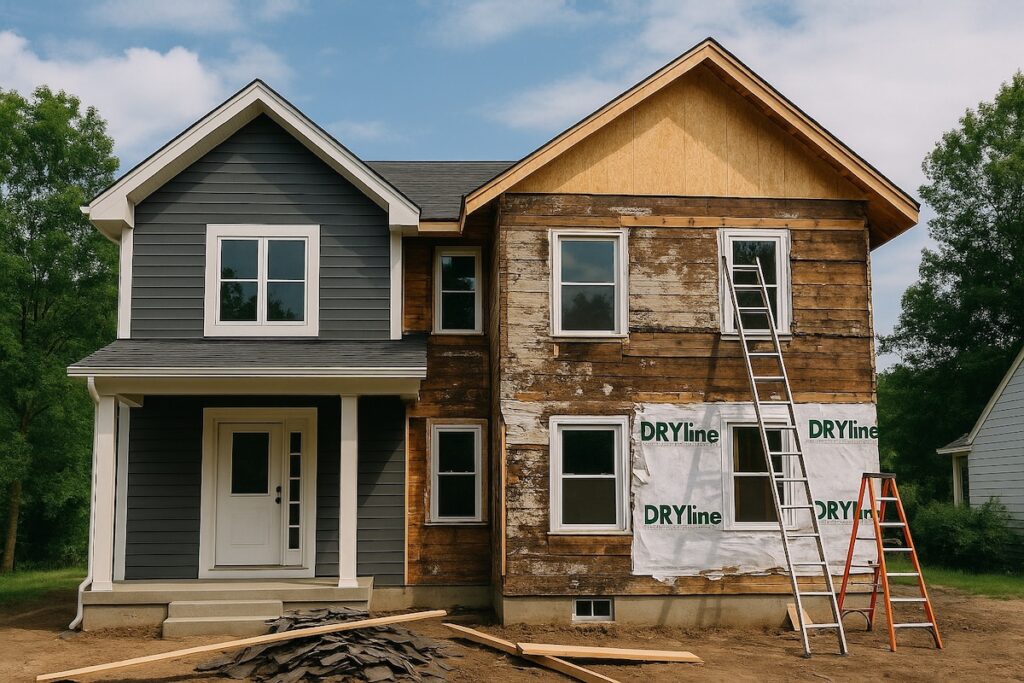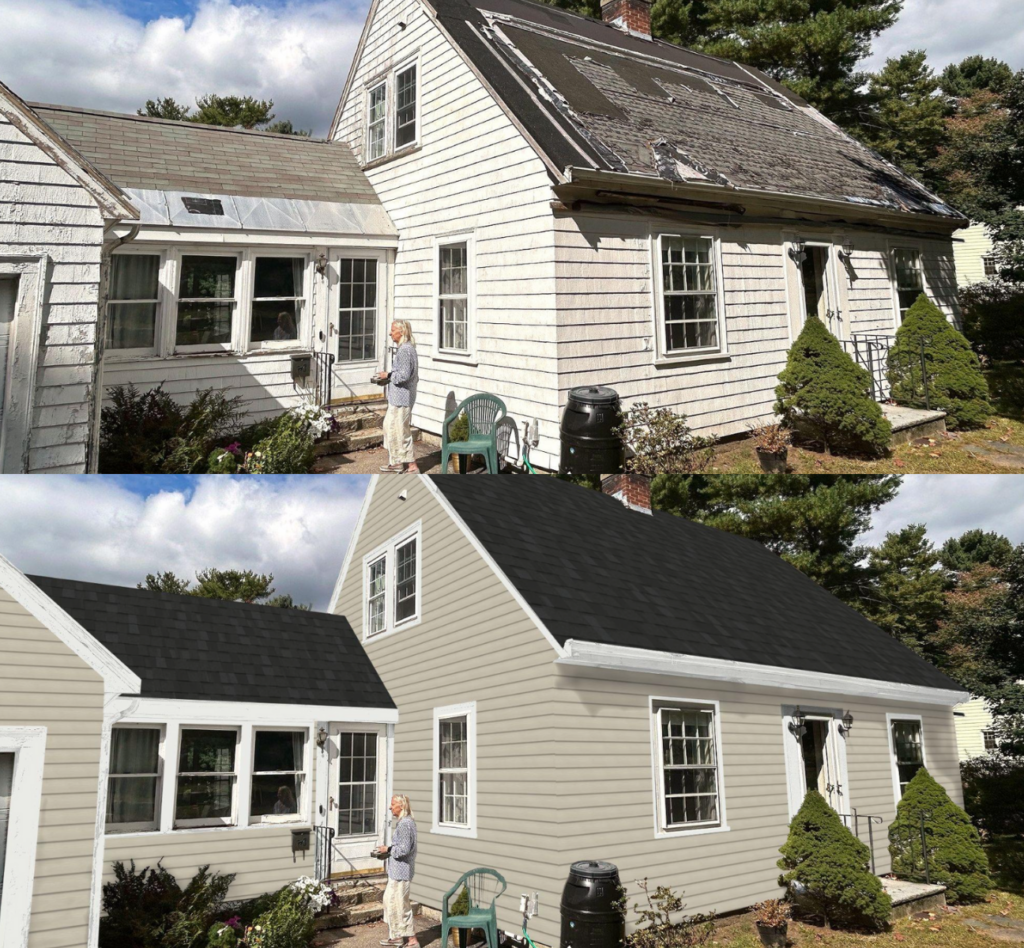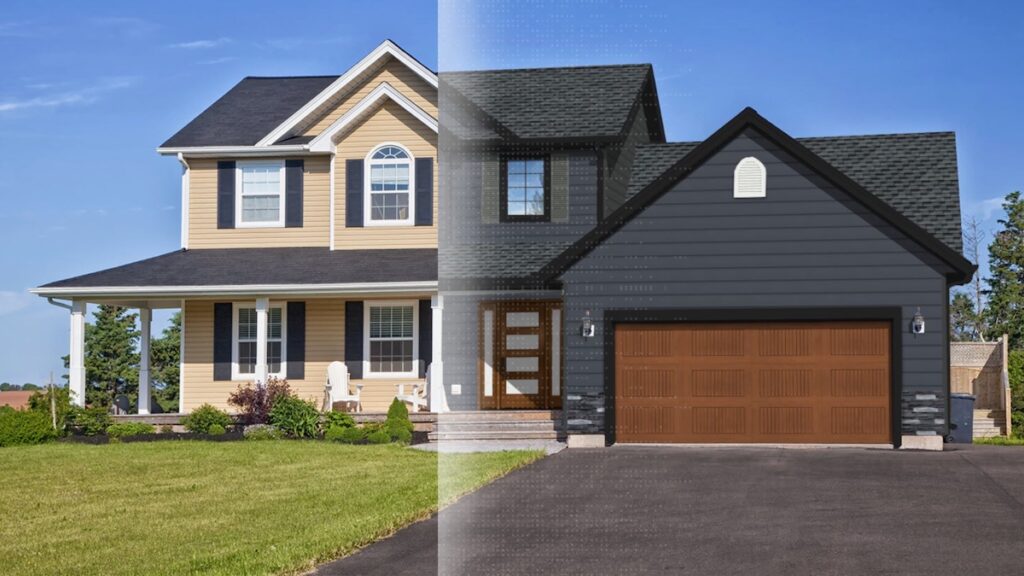TLDR
If you’re short on time but want a quick breakdown of what vinyl siding offers in 2025, here’s everything you need to know at a glance.
Average cost per sq ft: $2–$7 (standard) / $5–$10 (insulated)
Total cost for 2,000 sq ft home: $6,000–$14,000
Popular styles: Clapboard, Dutch lap, board and batten, vinyl shake, brick-look
Cheapest siding alternative: Standard horizontal vinyl siding
Top competitors: Fiber cement, wood, brick
Want to see how these styles and materials would look on your home? Try our free siding visualizer to explore your options in real time.
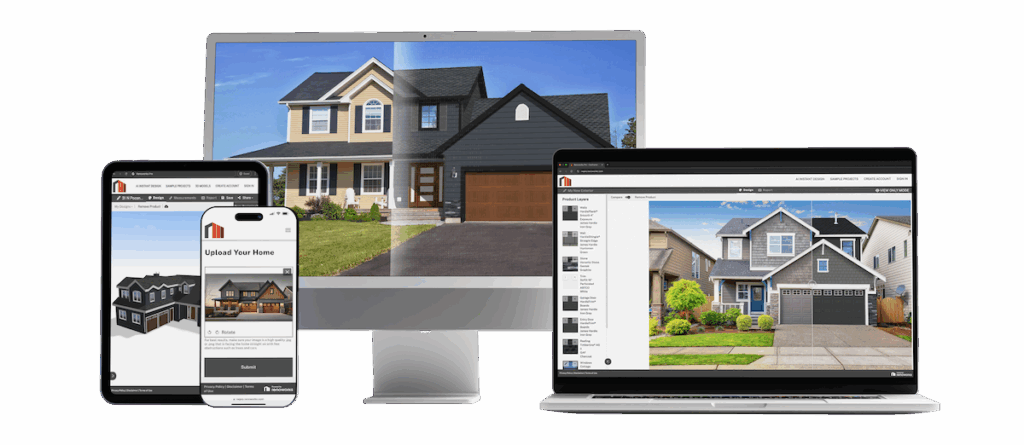
Introduction
When it comes to upgrading your home’s exterior, vinyl siding remains one of the most cost-effective and versatile options available. Whether you’re renovating for curb appeal, energy efficiency, or long-term durability, vinyl siding offers a compelling blend of benefits—without breaking the bank. In this comprehensive guide, we’ll explore real pricing data, compare vinyl to other siding materials, and highlight the key benefits that make it a top choice for homeowners across North America.
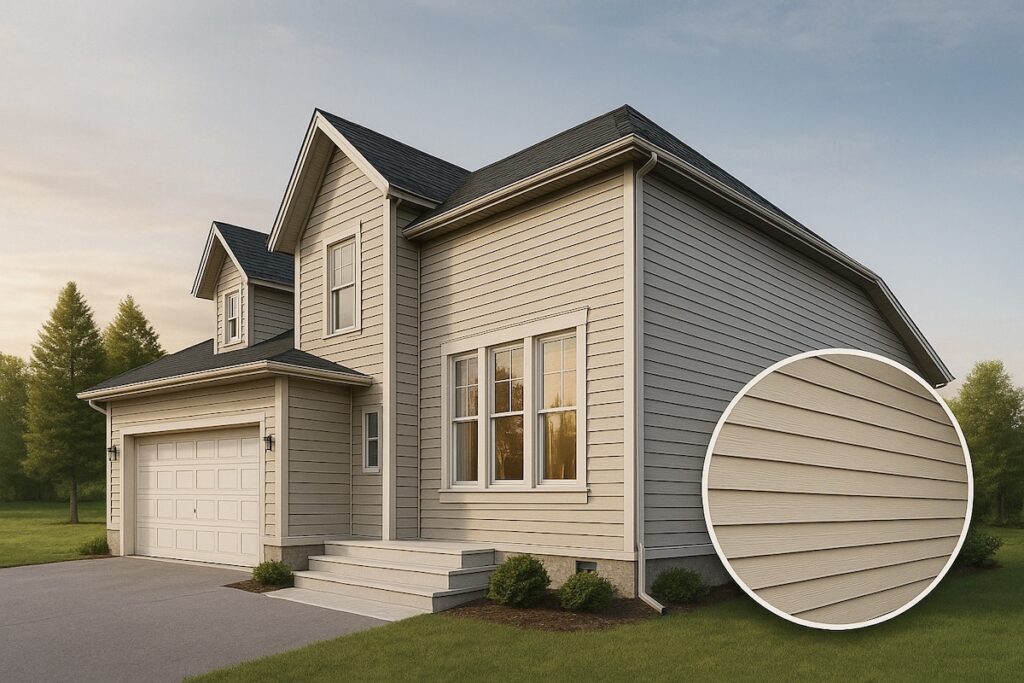
Vinyl Siding Cost Per Square Foot
Vinyl siding typically costs between $2 and $7 per square foot for standard styles. For insulated vinyl siding, prices can reach $10 per square foot due to added foam backing for energy efficiency and noise reduction.
| Siding Type | Cost Per Sq Ft | Notes |
|---|---|---|
| Standard Vinyl Siding | $2 – $4 | Most affordable option |
| Insulated Vinyl Siding | $5 – $10 | Boosts thermal performance |
| Vinyl Shake Siding | $4 – $9 | Decorative, textured |
| Board & Batten Vinyl | $3 – $8 | Vertical layout, trendy look |
| Brick-Style Vinyl | $4 – $10 | Imitates real brick affordably |
Total Vinyl Siding Cost by Home Size
Here’s what you can expect to pay based on your home’s size:
| Home Size (Sq Ft) | Low-End Cost | High-End Cost |
|---|---|---|
| 1,000 sq ft | $3,000 | $7,000 |
| 1,500 sq ft | $4,500 | $10,500 |
| 2,000 sq ft | $6,000 | $14,000 |
| 2,500 sq ft | $7,500 | $17,500 |
| 3,000 sq ft | $9,000 | $21,000 |
Note: Pricing includes labor and materials. Homes with architectural features, older siding removal, or premium vinyl side options may fall on the higher end.
What Impacts Vinyl Siding Installation Cost?
Your total vinyl side cost depends on:
House size and exterior complexity
Local labor rates and demand
Siding material grade (economy vs premium)
Whether old siding needs removal
Type of siding: vertical, shake, brick-style
Add-ons like trim, soffit, fascia, and insulation
To minimize cost, opt for standard horizontal panels and consider off-season installation.
Types of Vinyl Siding Materials
Not all vinyl is created equal. Here are common siding materials and their visual impact:
| Style | Best For | Avg Cost (Sq Ft) |
|---|---|---|
| Clapboard | Traditional and suburban homes | $2 – $5 |
| Dutch Lap | Shadowed texture, colonial look | $3 – $6 |
| Board and Batten | Modern farmhouse designs | $3 – $8 |
| Vinyl Shake | Rustic cottages, accent walls | $4 – $9 |
| Brick-Style Vinyl | Classic or urban feel | $4 – $10 |
| Vertical Siding | Clean, modern aesthetic | $3 – $7 |
Some premium vinyl siding includes woodgrain texture, offering the appearance of real wood siding with none of the maintenance.
Vinyl Siding vs Other Siding Materials
Here’s how vinyl stacks up against fiber cement, wood, and other options:
| Siding Material | Avg Cost (Sq Ft) | Lifespan | Maintenance | Appearance |
|---|---|---|---|---|
| Vinyl | $2 – $7 | 20–40 years | Low | Wide design variety |
| Fiber Cement | $5 – $13 | 30–50 years | Medium | Realistic wood mimic |
| Wood | $6 – $12 | 15–30 years | High | Authentic, classic look |
| Brick | $9 – $20 | 50–100 years | Very Low | Timeless, durable |
| Stone Veneer | $10 – $25 | 20–75 years | Low | High-end, luxury feel |
Exploring Additional Siding Types and Contractor Considerations
When evaluating your home’s exterior, it’s important to understand the full range of siding types available. Beyond vinyl, wood, and fiber cement, there are other materials gaining popularity in 2025. Aluminum siding, for example, is lightweight, rust-resistant, and offers a clean modern aesthetic, making it ideal for urban builds or accessory units. Brick siding continues to be favored for its unmatched durability and timeless style—though it’s one of the most expensive options available.
House siding comes in many forms, and each type has its own strengths in terms of maintenance, lifespan, and curb appeal. For instance, homeowners prioritizing fire resistance might lean toward fiber cement siding, while those seeking low cost and fast installation may choose standard vinyl siding or aluminum panels. If insulation is a concern, insulated vinyl siding and engineered wood offer significant benefits for energy efficiency.
When considering siding installation, partnering with a qualified siding contractor is critical. Contractors with experience in multiple siding types can help you balance cost, style, and performance. Look for licensed professionals who offer warranties and have proven reviews in your area.
Lastly, while vinyl siding is often marketed as a budget-friendly solution, homeowners should look beyond just material cost. True siding costs include labor, demolition of old siding, potential insulation upgrades, and accessories like fascia or soffits. Being clear on the full scope ensures you avoid surprise charges and get the most from your investment.
Vinyl remains one of the cheapest siding materials while providing broad visual appeal and low upkeep—making it ideal for budget-conscious homeowners.
HOME VISUALIZER TOOL
Still Imagining? Start Designing.
Visualize your home — for free. Instantly explore siding styles, colors, and renovations with just one photo. No forms. No pressure. Just results.
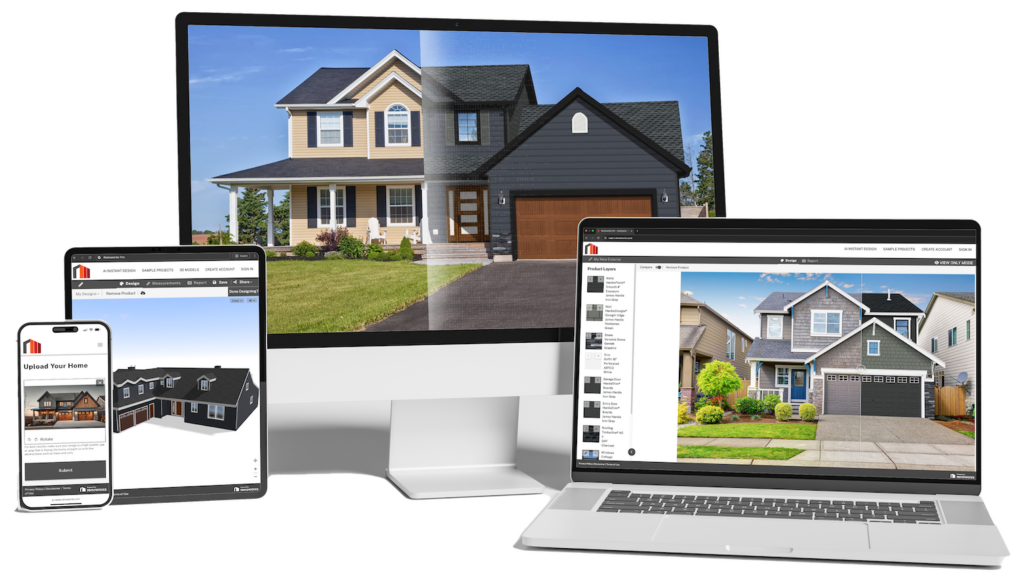
Benefits of Installing Vinyl Siding
Installing vinyl siding offers more than just curb appeal:
Affordability: One of the lowest cost-per-square-foot options
Quick installation: Saves on labor hours and project timeline
Low maintenance: No painting or sealing required
Energy efficiency: Insulated versions help lower HVAC costs
Style flexibility: Choose from dozens of colors, textures, and profiles
Cost-Saving Tips for Vinyl Siding Installation
Looking to trim your vinyl siding installation budget? Try this:
Book during off-peak seasons (late fall/winter)
Choose standard instead of designer panels
Prep your exterior in advance to reduce labor time
Request 2–3 contractor quotes
Install siding in tandem with roofing or window projects
Is Insulated Vinyl Siding Worth It?
Insulated vinyl siding improves energy efficiency and can extend panel lifespan. Though it costs more up front, the ROI is notable:
Reduces heating and cooling loss
Increases wall strength and noise resistance
Improves overall comfort in extreme climates
If your home lacks wall insulation, insulated vinyl siding may offset that deficiency.
Vinyl Siding Longevity and Maintenance
Vinyl siding typically lasts between 20 and 40 years. To extend its life:
Power wash once a year
Repair cracks or warped areas promptly
Avoid direct grilling heat or harsh chemical cleaners
Premium vinyl products with UV coating and deeper profiles tend to last longer.
More Considerations When Choosing Siding
Your siding choice should reflect your:
Climate zone (heat, humidity, wind)
Architectural style (contemporary, traditional, rustic)
Budget and appetite for maintenance
Sustainability preferences (recyclability, energy efficiency)
While wood siding might be right for a lakefront cabin, fiber cement or insulated vinyl may perform better on a suburban or high-exposure property.
What Are the Most Popular Siding Options in 2025?
Top exterior siding options today include:
Vinyl siding (in board and batten, shake, and brick-look styles)
Fiber cement siding (like James Hardie)
Engineered wood siding
Metal panels (aluminum and steel)
Brick and stone veneers
Each siding material comes with trade-offs in cost, longevity, and installation complexity.
Conclusion and Final Thoughts
As you evaluate the best path for your home exterior upgrade, vinyl siding emerges as one of the most balanced choices on the market. With a range of price points, low maintenance requirements, and an impressive selection of siding options—from clapboard to board and batten to insulated styles—there’s a solution that fits both your budget and design goals. Vinyl’s ease of installation and resistance to common wear like moisture, insects, and weather changes make it a go-to for homeowners looking to protect their investment while enhancing curb appeal.
One of vinyl siding’s key strengths is its adaptability. Whether you’re aiming for a sleek modern look or a rustic farmhouse finish, vinyl can imitate natural textures like wood or brick while avoiding the ongoing upkeep those materials require. For those prioritizing energy efficiency, insulated vinyl siding options provide meaningful returns over time, reducing heating and cooling costs year-round.
It’s also worth noting the competitive landscape. Alternatives like fiber cement, aluminum siding, engineered wood, or brick veneer all have their place in today’s siding market, but they typically come with trade-offs—either in price, installation complexity, or long-term maintenance. Vinyl siding sits at the intersection of affordability, longevity, and customization.
Finally, partnering with a professional siding contractor ensures you get the most from your investment. An expert can help you evaluate your local climate, choose the right material grade, and plan for long-term performance. Don’t just think about the upfront siding costs—think about the years of durability and style you’re adding to your home.
If you’re still unsure what style fits your home best, try the Renoworks Home Visualizer tool. It lets you preview various siding materials and colors on a digital rendering of your actual home. It’s the perfect next step to take your siding plans from idea to reality.
Frequently Asked Questions
How much does siding installation cost with labor?
Total costs average $6,000–$14,000 for a 2,000 sq ft home. Labor alone may account for 30%–50% of this depending on complexity.
What’s the difference between vinyl side installation and fiber cement?
Vinyl is faster, lighter, and simpler to install. Fiber cement is heavier and more durable but needs more specialized tools and labor.
Which siding materials hold up best in extreme climates?
Fiber cement siding and insulated vinyl are both top performers in high-wind, high-heat, or freeze-thaw environments.
What’s the best season to install vinyl siding?
Fall and early spring offer mild weather and less contractor demand—perfect for cost savings and fewer weather delays.
Horizontal vs vertical vinyl siding: which is better?
Horizontal is easier to install and more traditional. Vertical styles like board and batten are rising in popularity for modern homes.
How do I pick the right vinyl siding color?
Consider your roof color, trim, and landscaping. Lighter shades stay cooler and require less maintenance.
Can vinyl siding improve energy efficiency?
Yes—especially insulated vinyl siding, which reduces air leakage and thermal bridging.
Are there different grades of vinyl siding?
Yes. Builder-grade is cheapest siding but less durable. Premium vinyl includes deeper panels, stronger locks, and longer warranties.
How is vinyl siding installed?
Panels are nailed into place in overlapping rows. Proper spacing allows expansion. Starter strips, flashing, and vents help keep water out.
Can I install vinyl siding myself?
It’s possible for skilled DIYers, but improper installation can void warranties or lead to warping. Pros recommended.
Is vinyl siding waterproof?
It’s water-resistant—not waterproof. Proper housewrap and flashing are essential.
Can vinyl siding be painted?
Yes, with vinyl-safe exterior paint. Lighter colors are safer to avoid heat-related warping.
Does vinyl siding add value to a home?
Absolutely. New siding boosts curb appeal, energy efficiency, and resale value—making it a solid investment.
If you’re ready to explore your options, the Renoworks Home Visualizer lets you preview siding materials and colors on your actual home.


